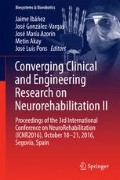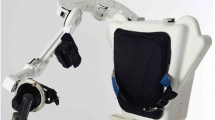Abstract
Robotic Neuro Rehabilitation has been proved to be effective for motor recovery and less demanding for therapists. During a therapy, the aim of the task is to maximize the patient’s effort with respect to his/her clinical status and motor abilities, improving at the same time his/her impaired movements. In this paper, we propose a framework for performance evaluation of post-stroke subjects able to provide assistance-as-needed based on their motor skills during a therapy session with an upper-limb robotic exoskeleton.
Similar content being viewed by others

1 Introduction
Acquired brain injuries (e.g., stroke) are the leading cause of serious disabilities restricting the daily functions of millions of patients. Effective therapy should be repetitive [1], intense [2], long term [3], and task specific [4, 5]. The use of robotic devices in rehabilitation exercises allows to provide repetitive and intense sessions without the physical involvement of the therapist, also enhancing patients’ motivation. Clinical trials investigating the efficacy of robotic rehabilitation provided evidence that robotic therapy is effective for motor recovery, also featuring high potential in improving functional independence of patients [6].
To involve patients in the task execution, the robot should provide assistance only when needed [7], tailoring the task difficulty in accordance with the patient’s motor competencies [8]. To this purpose, in this paper we investigate a control approach to automatically estimate motor patient’s abilities within an inter-joint coordination task, to be used as feedback for the assistance control. The proposed neuro-rehabilitation scenario consists of (i) ALEx ® robotic upper-limb exoskeleton [9], and (ii) a Virtual Environment used to present the task and provide visual feedback to the patient. The exoskeleton helps the patient with assistance-as-needed, guiding his/her movements and providing facilitation for guidance (plane constraint) and gravity support. However, analytical techniques are not always adequate to address inter-patient variability in stroke, and to associate requirements of adaptability. For this reason, Artificial Intelligence algorithms, that can automatically adapt to patients’ needs, have already been applied to generate a tailored feedback for each single patient. In this framework we use a Genetic Algorithm (GA) that gathers information from the task execution and exploit them to select the proper amount of assistance for the upcoming sessions, instead of choosing a predefined difficulty level, resulting in a system adaptable to the single patient.
2 The Proposed Robotic-Based Neuro-Rehabilitation System
The proposed system allows to perform a simple pursuing task requiring inter-joint coordination of elbow and shoulder. The patient is asked to pursue a sphere moving along a predefined trajectory. The evaluation framework is intend to compare the patient’s performance to the reference geometrical trajectory. As shown in the block diagram in Fig. 1, the system uses a GA to estimate the geometrical trajectory followed by the patient, which is used for the evaluation of his/her performance index. This kind of heuristic research algorithm has been chosen, instead of an analytical nonlinear programming solver, due to its adaptability to multi-variable problems and its ability to find good solutions within a reasonable time. Finally, the performance index is used to tune the proper level of assistance required.
2.1 Robotic Exoskeleton
The system integrates ALEx (see Fig. 2), a six Degrees of Freedoms (DoFs) mechanically compliant exoskeleton for human upper limbs, designed for post-stroke patients and suitable for interactions in 2D/3D virtual environments. The exoskeleton features four sensorized and actuated DoFs (for shoulder abduction-adduction, rotation, flexion-extension, and elbow flexion-extension) in addition to two sensorized and passive joints (for forearm prono-supination and wrist flexion-extension).
2.2 Training
During the task, the patient is asked to chase a virtual sphere that moves along a predefined trajectory \(T_r\). The geometrical shapes used as reference trajectories are (i) convex polygons, and (ii) ellipses. The robot can provide assistance to help the patient completing the task. The aid is realized by connecting the robot end effector to the target with a virtual coupling, forcing the patient’s arm to follow the target’s movements along \(T_r\). The stiffness can be changed according to patients needs, varying the level of assistance provided; therefore, the task gets easier for higher stiffness values. Figure 3 shows the control scheme of the robotic system. The interaction force F, applied on the patient in the control point, is evaluated to make the robot react to the error between the desired position \(X_d\) and the estimated position \(X_m\) of the control point with a viscoelastic response.
2.3 Evaluation
At the end of the task, the patient’s performance is calculated considering (i) the fitted geometric shape \(T_p\) modulated by the set of points (Point Cloud) representing the patient’s movements, and (ii) the differences between the end-effector and the target position over time.
A specifically designed GA is executed to fit the points describing the patient’s movements. For each kind of geometrical shapes (rectangle, ellipses, etc.), the algorithm generates a population of shapes (phenotypes) that evolves toward higher performance solutions, mimicking the process of natural selection. The system has been tested on one post-stroke patient (male, 65 years old) and one healthy subject (male, 28 years old). Both the subjects performed the same task having a rectangular-shaped trajectory (20 \(\times \) 40 cm). The GA provided an average error of 0.36 ± 0.31 cm for the healthy subject and 1.01 ± 0.81 cm for the unhealthy one. The fitting results of the procedure are shown in Fig. 4. Future works will exploit these values providing a relationship between patient’s skills and the amount of assistance he/she needs, once combined with the position of the end effector over time.
3 Conclusion and Future Work
In this work, we proposed a robotic system evaluating patients’ motor skills during a neuro-rehabilitation therapy task based on ALEx exoskeleton. Future works will include the evaluation of the difficulty level by back-forwarding the results of the session, to maximize patient’s performance minimizing the assistance to provide with respect of his/her motor skills.
References
C. Bütefisch, H. Hummelsheim, P. Denzler, K.-H. Mauritz, Repetitive training of isolated movements improves the outcome of motor rehabilitation of the centrally paretic hand. J. Neurol. Sci. 130(1), 59–68 (1995)
G. Kwakkel, R.C. Wagenaar, J.W. Twisk, G.J. Lankhorst, J.C. Koetsier, Intensity of leg and arm training after primary middle-cerebral-artery stroke: a randomised trial. Lancet 354(9174), 191–196 (1999)
A. Sunderland, D. Tinson, E. Bradley, D. Fletcher, R.L. Hewer, D. Wade, Enhanced physical therapy improves recovery of arm function after stroke. A randomised controlled trial. J. Neurol. Neurosurg. Psychiatry 55(7), 530–535 (1992)
M. Bergamasco, A. Frisoli, M. Fontana, C. Loconsole, D. Leonardis, M. Troncossi, M.M. Foumashi, V. Parenti-Castelli, Preliminary results of bravo project: brain computer interfaces for robotic enhanced action in visuo-motor tasks, in IEEE International Conference on Rehabilitation Robotics (ICORR), 2011 (IEEE, 2011), pp. 1–7
C. Loconsole, F. Stroppa, V. Bevilacqua, A. Frisoli, A robust real-time 3d tracking approach for assisted object grasping, in Haptics: Neuroscience, Devices, Modeling, and Applications (Springer, 2014), pp. 400–408
K. Nykänen, The effectiveness of robot-aided upper limb therapy in stroke rehabilitation: a systematic review of randomized controlled studies (2010)
H.I. Krebs, M. Krams, D.K. Agrafiotis, A. DiBernardo, J.C. Chavez, G.S. Littman, E. Yang, G. Byttebier, L. Dipietro, A. Rykman et al., Robotic measurement of arm movements after stroke establishes biomarkers of motor recovery. Stroke 45(1), 200–204 (2014)
R. Colombo, I. Sterpi, A. Mazzone, C. Delconte, F. Pisano, Taking a lesson from patients’ recovery strategies to optimize training during robot-aided rehabilitation. IEEE Trans. Neural Syst. Rehabil. Eng. 20(3), 276–285 (2012)
E. Pirondini, M. Coscia, S. Marcheschi, G. Roas, F. Salsedo, A. Frisoli, M. Bergamasco, S. Micera, Evaluation of a new exoskeleton for upper limb post-stroke neuro-rehabilitation: Preliminary results, in Replace, Repair, Restore, Relieve–Bridging Clinical and Engineering Solutions in Neurorehabilitation (Springer, 2014), pp. 637–645
Acknowledgments
This work has been partially supported by RONDA project funded by Regione Toscana, Italy, within the FAS ‘Salute’ 2014 program.
Author information
Authors and Affiliations
Corresponding author
Editor information
Editors and Affiliations
Rights and permissions
Copyright information
© 2017 Springer International Publishing AG
About this paper
Cite this paper
Stroppa, F., Loconsole, C., Marcheschi, S., Frisoli, A. (2017). A Robot-Assisted Neuro-Rehabilitation System for Post-Stroke Patients’ Motor Skill Evaluation with ALEx Exoskeleton. In: Ibáñez, J., González-Vargas, J., Azorín, J., Akay, M., Pons, J. (eds) Converging Clinical and Engineering Research on Neurorehabilitation II. Biosystems & Biorobotics, vol 15. Springer, Cham. https://doi.org/10.1007/978-3-319-46669-9_83
Download citation
DOI: https://doi.org/10.1007/978-3-319-46669-9_83
Published:
Publisher Name: Springer, Cham
Print ISBN: 978-3-319-46668-2
Online ISBN: 978-3-319-46669-9
eBook Packages: EngineeringEngineering (R0)







